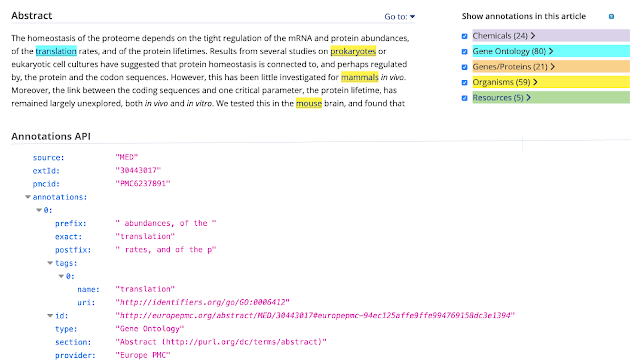**Europe PMC POSI update – 2 years on ** Two years have sailed by since Europe PMC adopted the Principles of Open Scholarly Infrastructure (POSI) in February 2021. POSI is a set of guidelines for open scholarly infrastructure providers and outlines how these organisations should be run and sustained. It offers a framework to uphold transparency and accountability.
Messaggi di Rogue Scholar
Markus Strasser (@mkstra write a fascinating article entitled "The Business of Extracting Knowledge from Academic Publications". His TL;DR: After recounting the many problems of knowledge extraction - including a swipe at nanopubs which "are ... dead in my view (without admitting it)" - he concludes: Well worth a read, and much food for thought.

The Plazi project has become one of the major contributors to GBIF with some 36,000 datasets yielding some 500,000 occurrences (see Plazi's GBIF page for details). These occurrences are extracted from taxonomic publication using automated methods.

[From algorithms to the bench]{style=“color: #666666; font-family: "arial"; font-size: 15pt; vertical-align: baseline; white-space: pre-wrap;”} [Text-mining holds the promise of helping researchers to overcome information overload. It is a familiar premise: an avalanche of scientific knowledge is being produced and shared.
The Apache Tika parser is like the Babel fish in Douglas Adam’s book, “The Hitchhikers’ Guide to the Galaxy” 1 . The Babel fish translates any natural language to any other. Although Tika does not yet translate natural language, it starts to tame the tower of babel of digital document formats. As the Babel fish allowed a person to understand Vogon poetry, Tika allows an analyst to extract text and objects from Microsoft Word.
The problem Text-mining - the art of answering questions by extracting patterns, data, etc. out of the published literature - is not easy. It’s made incredibly difficult because of publishers. It is a fact that the vast majority of publicly funded research across the globe is published in paywall journals.
[We are excited to announce the launch of Europe PMC Annotations API, which provides programmatic access to annotations text-mined from biomedical abstracts and open access full text articles. The Annotations API is a part of Europe PMC’s programmatic tools suit and is freely available on the Europe PMC website: ]{style=“font-family: "arial"; font-size: 11pt;

[Manual curation is vital for maintaining quality information in biological databases. However, with the exponential growth in biological data this approach is both challenging and time consuming. We wanted to create a scalable and sustainable process which could complement manual curation. ]{style=“color: #494949; font-family: "open sans" , "helvetica neue" , "helvetica" , "arial" , sans-serif;”}[ ]{style=“color: #494949;

This post is a response to Ross Mounce's post Text mining for museum specimen identifiers. As Ross notes in that post, mining literature for specimen codes is something I've been interested in for a while (search for specimen codes on iPhylo), and @Aime Rankin (formerly an undergraduate student at Glasgow) did some work on this as well. It's great to see progress in this area.
[Evidence Finder (EvF) provides a new way of searching Europe PMC that will help you find the most relevant articles more quickly. By surfacing “facts” based on biological concepts, EvF enhances the Europe PMC search, targeting relevant sentences from within full text articles. Over the next few weeks, we will be running an experiment on the Europe PMC website that will incorporate EvF and explore how it is used.]{style=“background-color: white;